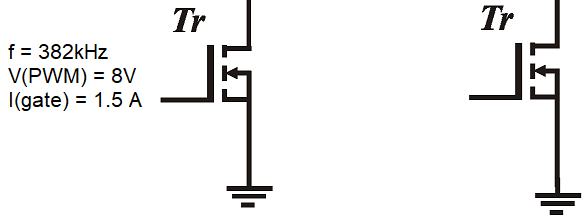I have a push-pull converter that uses BSC040N10NS5ATMA1 MOSFETs. I have also tried using CSD19533Q5A MOSFETs.
The FETs keep blowing at low power output (about 15 W). I am trying to get to 100 W. They fail to a short circuit. When I replace a FET, it happens again. Here is my circuit:
Things I have tried and verified:
- Gate-source resistor: currently set to 10 kΩ
- Gate drive resistor: currently set to 1 Ω, have used as high as 3 Ω
- The duty cycle, turn-on time, and frequency are such that the gate voltage waveforms are not overlapping, so I do not think cross-conduction is the problem. Acutal duty cycle is still a bit higher than design duty cycle (40% vs. 30%), but the waveforms do not appear to overlap and the driver adds in about 40 ns of dead time.
- The diodes in the snubber are very fast, part number UF4004.
- I cranked up the gate drive and current as shown in the circuit and I am pretty sure I am fully turning on the MOSFET.
- I also tried to use the FETs in parallel to reduce current per FET, and made sure to apply parallel gate driving, I see the same problem at the same power level (about 15 W)
I think the problem is that my resistor in the RCD snubber is wrong, but I don't know if it is too large or too small.
Any ideas?
EDIT 1: Inductance measurement
Leakage inductance is high actually about 4 μH, Primary inductance is actually 280 μH, turns ratio is accurate. Edited in image above.
EDIT 2: V(DS) and V(GS) measurements
Initially I measured V(DS) using the RCD clamp values above, and I saw that V(DS) was spiking above 100 V at 15 W output, which is beyond the allowed value for the BSC040N10NS5ATMA1.
I changed the snubber values in the hopes that this would clamp V(DS). My measurement with C in the clamp replaced with 6.8 nF is shown in the photo. This was also taken at 15 W.
V(DS) is getting pretty close to 100 V. Also R in my RCD clamp was getting so hot that it looked like it was desoldering itself. A measurement of the capacitor shows that it completely discharges and rings during each cycle due to the low time constant.
V(GS) was a nice clean square wave on both MOSFETs with no ringing, found to be about 50 ns rise time.








